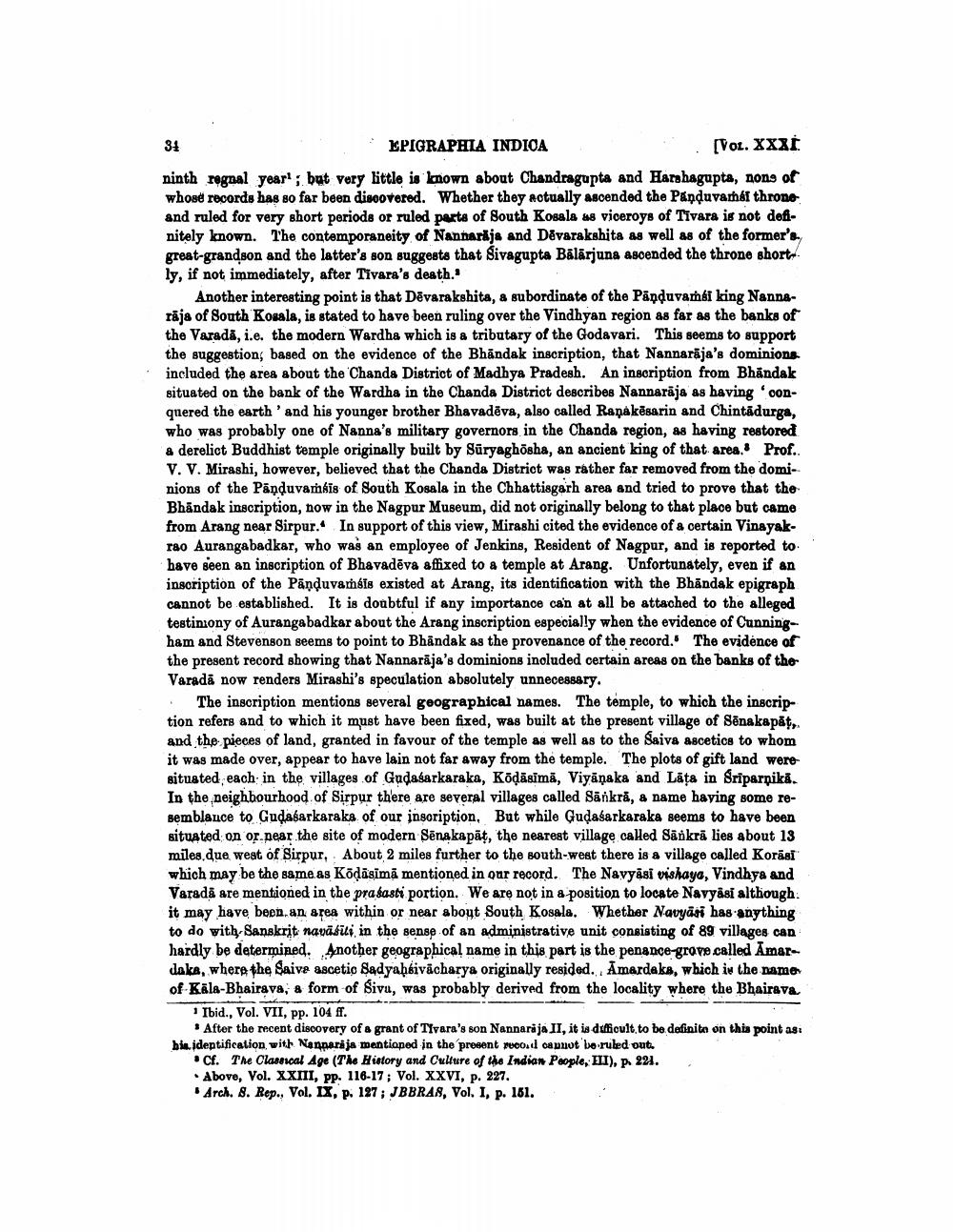________________
31
EPIGRAPHIA INDICA
[VOL. XXXI
ninth regnal year; but very little is known about Chandragupta and Harshagupta, nons of whose records has so far been discovered. Whether they actually ascended the Panduvamál throne and ruled for very short periods or ruled parts of South Kosala as viceroys of Tivara is not definitely known. The contemporaneity of Nannaräja and Devarakshita as well as of the former's great-grandson and the latter's son suggests that Sivagupta Bālārjuna ascended the throne short ly, if not immediately, after Tivara's death.'
Another interesting point is that Devarakshita, a subordinate of the Panduvaméi king Nannaraja of South Kosala, is stated to have been ruling over the Vindhyan region as far as the banks of the Varada, i.e. the modern Wardha which is a tributary of the Godavari. This seems to support the suggestion, based on the evidence of the Bhandak inscription, that Nannaräja's dominions. included the area about the Chanda District of Madhya Pradesh. An inscription from Bhandak situated on the bank of the Wardha in the Chanda District describes Nannaraja as having 'conquered the earth' and his younger brother Bhavadēva, also called Ranakesarin and Chintadurga, who was probably one of Nanna's military governors in the Chanda region, as having restored a derelict Buddhist temple originally built by Suryaghōsha, an ancient king of that area. Prof.. V. V. Mirashi, however, believed that the Chanda District was rather far removed from the dominions of the Panduvamsis of South Kosala in the Chhattisgarh area and tried to prove that the Bhandak inscription, now in the Nagpur Museum, did not originally belong to that place but came from Arang near Sirpur. In support of this view, Mirashi cited the evidence of a certain Vinayakrao Aurangabadkar, who was an employee of Jenkins, Resident of Nagpur, and is reported to have seen an inscription of Bhavadeva affixed to a temple at Arang. Unfortunately, even if an inscription of the Panduvamsis existed at Arang, its identification with the Bhandak epigraph cannot be established. It is doubtful if any importance can at all be attached to the alleged testimony of Aurangabadkar about the Arang inscription especially when the evidence of Cunningham and Stevenson seems to point to Bhandak as the provenance of the record. The evidence of the present record showing that Nannaraja's dominions included certain areas on the banks of the Varada now renders Mirashi's speculation absolutely unnecessary.
The inscription mentions several geographical names. The temple, to which the inscription refers and to which it must have been fixed, was built at the present village of Senakapāt, and the pieces of land, granted in favour of the temple as well as to the Saiva ascetics to whom it was made over, appear to have lain not far away from the temple. The plots of gift land weresituated each in the villages of Gudasarkaraka, Kōḍāsīmā, Viyāņaka and Lāța in Sriparnikā. In the neighbourhood of Sirpur there are several villages called Sankra, a name having some resemblance to Gudasarkaraka of our inscription. But while Guḍaśarkaraka seems to have been situated on or near the site of modern Senakapāt, the nearest village called Sänkrā lies about 13 miles due west of Sirpur, About 2 miles further to the south-west there is a village called Korasi which may be the same as Kōdāsīmā mentioned in our record. The Navyasi vishaya, Vindhya and Varada are mentioned in the prasasti portion. We are not in a position to locate Navyasi although. it may have been an area within or near about South Kosala. Whether Navyasi has anything to do with Sanskrit naväsili in the sense of an administrative unit consisting of 89 villages can hardly be determined. Another geographical name in this part is the penance-grove called Amardaka, where the Saive ascetic Sadyahsivacharya originally resided.. Amardaka, which is the name of Kala-Bhairava, a form of Siva, was probably derived from the locality where the Bhairava
1 Ibid., Vol. VII, pp. 104 ff.
After the recent discovery of a grant of Tivara's son Nannaraja II, it is difficult to be definite on this point as: bis identification with Nannaraja mentioned in the present record cannot be ruled out.
Cf. The Classical Age (The History and Culture of the Indian People, III), p. 221.
Above, Vol. XXIII, pp. 116-17; Vol. XXVI, p. 227.
Arch. 8. Rep., Vol. IX, p. 127; JBBRAS, Vol. I, p. 151.




